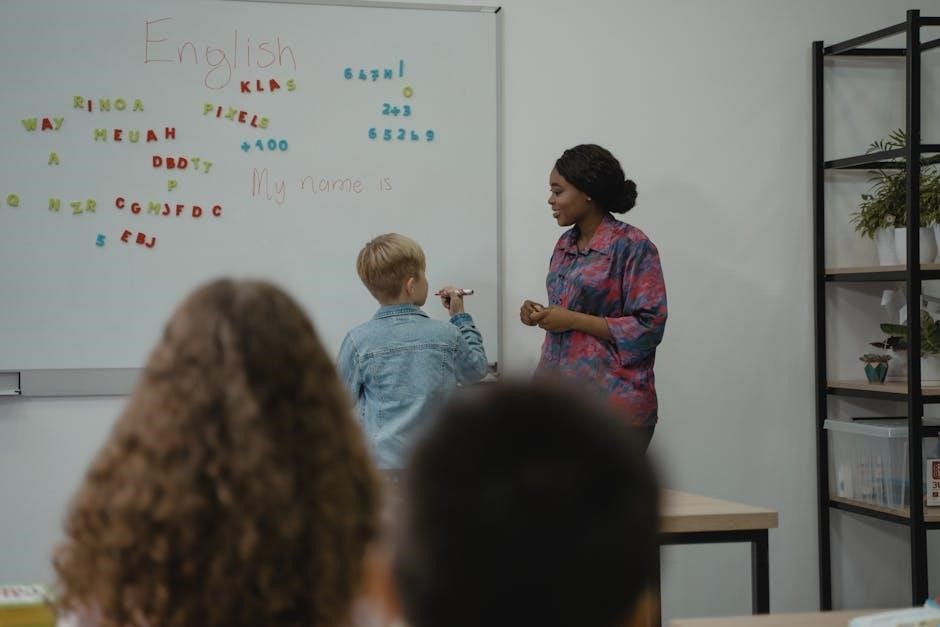Special education is crucial for addressing diverse student needs‚ providing tailored support‚ and ensuring inclusive learning environments. It equips educators with strategies to meet unique challenges effectively.
1.1 Understanding the Role of Special Education
Special education plays a vital role in supporting students with disabilities by providing tailored instruction and resources. It ensures that each student’s unique needs are met through individualized plans and collaborative efforts between general and special education teachers. The role involves creating inclusive environments‚ implementing IEPs and RTI plans‚ and using best practices to foster academic and social growth. Special education teachers act as advocates‚ ensuring equitable access to education and empowering students to reach their full potential.
1.2 The Importance of Inclusive Education
Inclusive education is essential for creating a supportive learning environment where all students‚ regardless of abilities‚ feel valued and empowered. It breaks down barriers‚ fostering a sense of belonging and equity. By integrating students with disabilities into general education classrooms‚ inclusive education promotes social interaction‚ mutual respect‚ and diverse perspectives. This approach not only benefits students with special needs but also enriches the learning experience for all‚ preparing them to thrive in a diverse society. Inclusive practices are key to ensuring every student reaches their full potential.

Legal Framework and Processes in Special Education
Understanding the legal framework in special education is vital for ensuring students with disabilities receive appropriate services and protections under laws like IDEA and Section 504.
2.1 Overview of Special Education Laws (IDEA‚ Section 504)
Special education laws‚ such as the Individuals with Disabilities Education Act (IDEA) and Section 504 of the Rehabilitation Act‚ ensure students with disabilities receive free‚ appropriate public education (FAPE) in the least restrictive environment (LRE). IDEA focuses on individualized education programs (IEPs) for students with specific disabilities‚ while Section 504 protects those with disabilities that substantially limit major life activities‚ providing 504 plans for accommodations. These laws guarantee equal access to education‚ promoting inclusion and support for diverse student needs.
2.2 Understanding Individualized Education Programs (IEPs)
An IEP is a legally binding document tailored to a student’s unique needs‚ outlining specific goals‚ services‚ and accommodations. Developed collaboratively by parents‚ educators‚ and sometimes administrators‚ it ensures personalized learning plans. The IEP includes present levels of performance‚ measurable annual goals‚ and progress monitoring strategies. Annual reviews update the plan to reflect student growth and changing needs‚ ensuring continuous support and alignment with educational objectives. This process guarantees students receive targeted interventions to thrive academically and socially.
2.3 Response to Intervention (RTI) Plans
Response to Intervention (RTI) plans are structured frameworks used to identify and support students with learning or behavioral challenges. RTI involves a multi-tiered approach‚ starting with universal classroom support and progressing to more targeted interventions. Schools use data from assessments and observations to determine the intensity of support needed. RTI plans help educators pinpoint specific student needs and monitor progress‚ ensuring effective interventions are implemented. This approach aligns with legal requirements and complements IEPs by providing a proactive strategy to address student difficulties early and effectively.

Instructional Strategies for Special Education
Effective strategies include differentiated instruction‚ assistive technology‚ and Universal Design for Learning (UDL) to meet diverse student needs‚ enhancing accessibility and engagement in the classroom.
3.1 Best Practices for the Inclusive Classroom
An inclusive classroom fosters a supportive environment where all students thrive. Best practices include differentiated instruction‚ Universal Design for Learning (UDL)‚ and assistive technology. Teachers should collaborate with special education staff‚ use visual aids‚ and incorporate flexible grouping. Clear communication and positive reinforcement also play key roles. By addressing diverse learning needs proactively‚ educators create equitable opportunities for academic and social growth‚ ensuring every student feels valued and empowered to succeed.
- Use differentiated instruction to meet varied learning needs.
- Implement Universal Design for Learning (UDL) principles.
- Leverage assistive technology for accessibility.
- Collaborate with special education teachers and support staff.
- Incorporate visual aids and multi-sensory approaches.
- Utilize flexible grouping strategies.
- Encourage student participation and engagement.
3.2 Accommodations and Modifications for Students with Disabilities
Accommodations and modifications are essential for ensuring students with disabilities access learning opportunities. Accommodations‚ like extended test time or assistive technology‚ help students complete tasks without altering standards. Modifications‚ such as simplified assignments‚ adjust expectations to meet individual needs. Both strategies are tailor-made in IEPs or 504 plans. Understanding the distinction is key to supporting diverse learners effectively‚ ensuring equity while maintaining high expectations for all students.
- Accommodations: Adjustments that don’t change learning goals.
- Modifications: Changes to content or expectations.
- Examples: Extended time‚ assistive technology‚ simplified materials.
- Legal frameworks: IEPs‚ 504 plans guide implementation.
3.4 Technology Tools to Support Special Education
Technology plays a vital role in supporting special education by providing tailored tools to meet diverse needs. Text-to-speech software aids students with reading difficulties‚ while interactive learning platforms engage learners with adaptive activities. Assistive devices‚ such as speech-to-text and mind mapping tools‚ enhance organization and communication. Online resources and apps offer personalized learning experiences‚ fostering independence and inclusivity. These tools empower teachers to create differentiated instruction‚ ensuring all students can access and succeed in their education.
- Text-to-speech for reading support.
- Interactive learning platforms for engagement.
- Assistive devices for organization and communication.
- Online resources for personalized learning.

Classroom Management and Behavioral Support
Effective classroom management and behavioral support are essential for creating a structured‚ respectful environment. Strategies like PBIS‚ clear expectations‚ and positive reinforcement help students thrive and stay focused.
4.1 Creating a Safe and Supportive Learning Environment
Creating a safe and supportive learning environment is vital for fostering engagement and success for all students. This involves designing structured‚ accessible spaces and promoting positive interactions. Teachers can use strategies like clear expectations‚ positive reinforcement‚ and restorative practices to build trust and respect. Incorporating accommodations and modifications ensures inclusivity‚ while active listening and empathy address emotional needs. Collaboration with parents and educators further strengthens this environment‚ ensuring every student feels valued and supported in their educational journey.
4.2 Positive Behavioral Interventions and Supports (PBIS)
Positive Behavioral Interventions and Supports (PBIS) is a proactive approach to fostering a positive classroom environment. It focuses on preventing problem behaviors through clear expectations‚ reinforcement of positive actions‚ and data-driven interventions. Teachers use assessments to identify behavioral challenges and implement tailored strategies. PBIS encourages consistency across settings‚ collaboration with parents‚ and the use of incentives to promote positive conduct. This framework supports social-emotional growth‚ reducing disruptions and enhancing academic engagement for all students‚ particularly those with special needs.

Assessments and Progress Monitoring
Assessments and progress monitoring are essential for guiding instruction‚ tracking student growth‚ and ensuring accountability. They help identify strengths‚ needs‚ and the effectiveness of educational strategies.
5.1 Using Assessments to Inform Instruction
Assessments are a cornerstone of special education‚ helping identify students’ strengths‚ needs‚ and progress. By analyzing data‚ teachers can tailor instruction to individual learning requirements. Regular evaluations‚ such as formative assessments‚ guide adjustments in teaching strategies‚ ensuring targeted support. These tools also inform IEP development and progress monitoring‚ enabling educators to track growth effectively. Leveraging assessment data fosters personalized learning‚ collaboration with parents‚ and continuous improvement in educational practices‚ ultimately enhancing student outcomes and academic success.
5.2 Data Management for Students with Disabilities
Effective data management is essential for supporting students with disabilities. Tools like progress monitoring and assessment results help track learning outcomes and inform instruction. Accurate record-keeping ensures compliance with legal requirements‚ such as IDEA. Data management systems streamline IEP development‚ collaboration‚ and reporting. Regular updates enable teachers and parents to make informed decisions‚ ensuring personalized support. Organized data management enhances accountability‚ improves communication‚ and supports continuous improvement in special education practices‚ ultimately benefiting student success and educational equity.

Collaboration and Communication
Collaboration between teachers‚ parents‚ and educators is vital for student success. Effective communication ensures aligned support‚ fostering teamwork and shared goals for students with disabilities.
6.1 Working with Parents and Guardians
Building strong partnerships with parents and guardians is essential for student success. Clear communication and collaboration ensure shared goals and consistent support for students with special needs.
Teachers should actively involve parents in the educational process‚ providing regular updates and seeking their input. This fosters trust and mutual understanding‚ benefiting the student’s development.
By working together‚ educators and families can address challenges effectively‚ ensuring tailored strategies align with the student’s unique requirements and strengths.
6.2 Collaborating with General Education Teachers
Collaboration between special and general education teachers is vital for creating inclusive classrooms. By sharing expertise and resources‚ they ensure comprehensive support for all students‚ addressing diverse learning needs effectively.
Co-teaching strategies and joint lesson planning are effective methods to integrate individualized instruction seamlessly. Regular communication and shared feedback enhance student outcomes and foster a collaborative school culture.

Professional Development and Resources
Professional development opportunities‚ online platforms‚ and journals provide teachers with essential tools to enhance their instructional strategies and support students with disabilities effectively.
7.1 Professional Development Opportunities for Teachers
Professional development opportunities for special education teachers include workshops‚ online courses‚ and conferences that enhance instructional skills. Resources like A Teacher’s Guide to Special Education provide practical strategies. Educators can access online platforms offering lesson plans and research articles. Collaborative communities and mentorship programs further support teacher growth. These opportunities ensure teachers stay updated on best practices‚ legal requirements‚ and innovative tools to effectively support students with disabilities and create inclusive learning environments. Continuous learning helps educators address diverse needs and improve student outcomes.
7.2 Online Resources and Journals for Special Education
Online resources and journals provide valuable support for special education teachers. Platforms like ASCD and Pearson offer lesson plans‚ research articles‚ and best practices. Journals such as Exceptional Children and Journal of Special Education share cutting-edge research. Websites like Understood.org and the National Center for Learning Disabilities offer practical tools and guides. These resources help educators enhance teaching strategies‚ stay updated on legal requirements‚ and access innovative tools to support students with disabilities effectively.

Addressing Diverse Student Needs
Addressing diverse student needs requires understanding learning disabilities‚ autism‚ ADHD‚ and tailoring strategies to meet individual requirements‚ ensuring inclusive and supportive learning environments for all students.
8.1 Teaching Students with Learning Disabilities

Teaching students with learning disabilities requires understanding their unique needs and implementing tailored strategies. Multisensory approaches‚ assistive technology‚ and positive reinforcement are effective methods. Creating an individualized learning plan ensures targeted support‚ while structured routines and clear expectations foster a conducive environment. Collaborating with specialists and using data-driven instruction helps track progress and adapt strategies. By addressing diverse needs‚ educators empower students to overcome challenges and achieve academic success‚ promoting inclusivity and personalized learning experiences.
8.2 Supporting Students with Autism and ADHD
Supporting students with autism and ADHD requires tailored strategies to address their unique needs. Structured routines‚ visual aids‚ and clear expectations help create a predictable environment. Positive reinforcement and behavioral interventions‚ such as PBIS‚ encourage positive behaviors. Sensory integration techniques and assistive technologies can enhance focus and engagement. Collaboration with specialists and consistent communication with parents are essential for developing effective support plans. By fostering empathy and understanding‚ educators can create an inclusive and supportive learning environment tailored to these students’ needs‚ promoting their academic and social growth.

Legal and Ethical Considerations
Special education involves legal and ethical responsibilities‚ ensuring compliance with laws like IDEA and Section 504; Ethical practices prioritize student rights‚ confidentiality‚ and equitable access to education.
9.1 Ethical Practices in Special Education
Ethical practices in special education ensure that teachers prioritize students’ well-being‚ respect diversity‚ and maintain confidentiality. These practices are guided by professional standards‚ fostering an inclusive and respectful learning environment. Teachers must advocate for students’ rights and ensure equitable access to resources. Additionally‚ ethical considerations involve ongoing professional development to stay updated on best practices and legal requirements. By adhering to these principles‚ educators create a supportive and fair educational setting for all students.
9.2 Advocacy for Students with Disabilities
Advocacy for students with disabilities involves ensuring their rights are protected and their needs are met. Teachers play a crucial role in advocating by collaborating with parents‚ administrators‚ and other educators to secure appropriate resources and support. This includes ensuring compliance with legal frameworks like IDEA and Section 504‚ as well as actively promoting inclusive practices. Effective advocacy also requires staying informed about legal updates and educational advancements to champion equitable opportunities for all students with disabilities‚ fostering their academic and personal growth.
This guide provides a comprehensive overview of special education‚ equipping teachers with strategies to support diverse learners. Applying these practices fosters inclusive classrooms and enhances student outcomes. Continuous professional development and advocacy are essential for advancing the field and ensuring all students thrive.
10.1 Applying What You’ve Learned
Implementing the strategies outlined in this guide can transform your teaching practice‚ fostering an inclusive and supportive environment. Start by integrating accommodations and modifications into lesson plans‚ ensuring each student’s needs are met. Collaborate with colleagues and parents to align goals and monitor progress. Use data-driven approaches to refine instruction and celebrate small victories. Advocating for students with disabilities is a lifelong commitment. By applying these principles‚ you empower learners to reach their full potential and create a lasting impact in their educational journey.
10.2 Continuing Your Journey in Special Education
Continuing your journey in special education requires commitment to lifelong learning and professional growth. Seek out workshops‚ online courses‚ and conferences to stay updated on best practices. Engage with professional communities and networks to share insights and gain new perspectives. Utilize resources like journals and online platforms to deepen your knowledge. Advocating for students with disabilities is an ongoing process. By staying informed and connected‚ you can continue to make a meaningful difference in the lives of your students and contribute to the evolving field of special education.